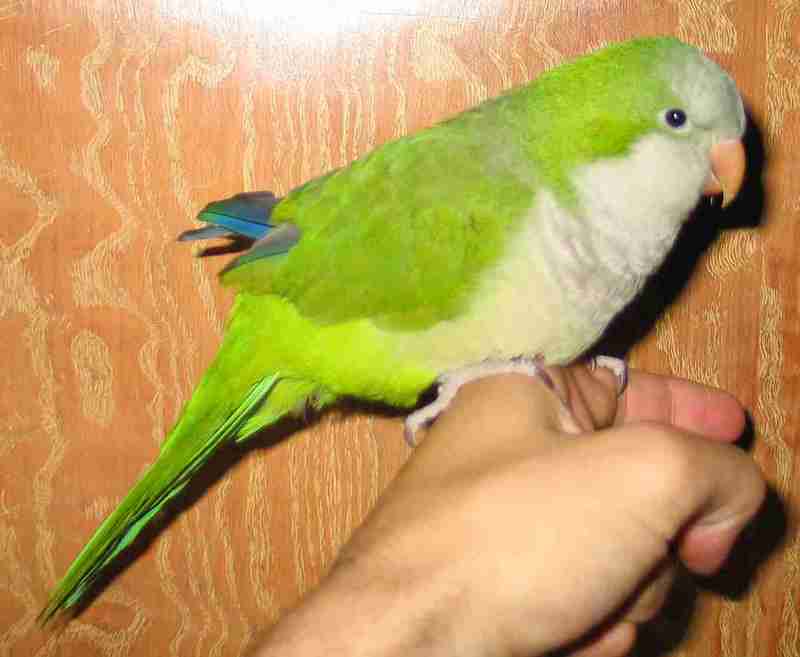Monk Parakeet (Myiopsitta monachus) - Wiki Monk Parakeet
From Wikipedia, the free encyclopedia
[Photo] Personal image made byen:User:BerserkerBen of pet quaker parrot. http://en.wikipedia.org/wiki/User:BerserkerBen
The Monk Parakeet (Myiopsitta monachus), also known as the Quaker Parrot, is a species of parrot that originated in the temperate areas of Argentina and Brazil in South America. It is the only member of the genus Myiopsitta.
There are four subspecies:
- M. m. monachus, southeastern Brazil, Uruguay, and northeastern Argentina
- M. m. calita, western and southern Argentina
- M. m. cotorra, southeastern Bolivia, Paraguay, northern Argentina, and southern Brazil
- M. m. luchsi an isolated population in Bolivia which is smaller and may deserve species status.
This parrot is, on average, 29 cm long with a 48 cm wingspan, and weighs 100 g. Females tend to be 10-20% smaller. It has bright green upperparts. The forehead and breast are pale grey and the rest of the underparts are very-light green to yellow. The flight feathers are dark blue, and the tail is long and tapering. The bill is orange. The call is a loud and throaty graaa or skveet. Domestic breeds have produced colors other than the natural plumage; these include white and blue in place of green.
The Monk Parakeet is the only parrot that builds a stick nest, in a tree or on a man-made structure, rather than using a hole in a tree. This gregarious species often breeds colonially, building a single large nest with separate entrances for each pair. In the wild, the colonies can become quite large, with pairs occupying separate "apartments" in nests that can reach the size of a small automobile. Their 5-12 eggs hatch in about 24 days.
Unusually for a parrot, Monk Parakeet pairs occasionally have helper individuals, often a grown offspring, which assists with feeding the young (see kin selection).
Monk Parakeets are highly intelligent, social birds. Those kept as pets routinely develop large vocabularies.
The Monk Parakeet was brought to the United States in the late 1960s as a pet. Many escaped or were intentionally released, and populations were allowed to proliferate. By the early 1970s, it was established in seven states, and by 1995 it had spread to eight more. There are now thought to be approximately 100,000 in Florida alone.
As one of the few temperate-zone parrots, the Monk Parakeet is more able than most to survive cold climates, and colonies exist as far north as New York City, Chicago and communities in coastal Rhode Island and Connecticut. This hardiness makes this species second only to the Rose-ringed Parakeet amongst parrots as a successful introduced species.
The lifespan of Monk Parakeets has been quoted to be from 15-20 years, to 25-30 years.
Problems with introduced populations
In Argentina, Brazil and Uruguay, Monk Parakeets are regarded as major agricultural pests (as Charles Darwin noted). Their population explosion in South America rural areas seems to be associated with the expansion of eucalyptus forestry for paper pulp production, which offers the bird the opportunity to build protected nests in artificial forests where there is small ecological competition from other species.In areas where they have been introduced, some fear that they will harm crops and native species. Evidence of the harm of these birds in introduced areas is disputed, and many people oppose killing a charismatic bird, but there have been local bans and eradication programs in some areas of the USA. Due to its invasive species status, a number of states outlaw either importation, sale, release , or mere possession of a monk parakeet. [3] [4]
Self-sustaining feral populations have been recorded in Europe, Israel, Bermuda, Puerto Rico, the Canary Islands and Japan. As it is an open woodlands species, it adapt readily to urban areas.The species has in recent years expanded its range in Brazil, where there is now a self-sustaining population in the downtown area of Rio de Janeiro.Since this expansion concerns discontinous areas, far from the bird's historical range,it is most probably a consequence of escapes from the pet trade. In Rio,the bird can be easily seem at the Aterro do Flamengo gardens - where it nests on palm trees and feeds on their fruit; the Rio birds seem to favor nesting amid the leaves of coconut palm trees - as well as in the vicinity of the neighbouring domestic flight terminal, the Santos Dumont Airport.Outside the USA, introduced populations do not appear to raise similar controversy, presumably because of smaller numbers of birds, or by the fact that their settlement in urban areas does not pose a threat to agricultural activities.
In addition they have found a home within Greenwood Cemetery in Brooklyn, New York after an accidental release decades ago. While the grounds crew initially tried to destroy the unsightly nests at the entrance gate, they no longer do so, because the presence of the parrots has reduced the number of pigeons nesting within it. The management's decision was based on a comparative chemical analysis of pigeon faeces (which destroy brownstone structures) and Monk Parakeet faeces (which have no ill effect). Oddly then, the Monk Parakeets are in effect preserving this historic structure.
http://en.wikipedia.org/wiki/Monk_Parakeet
| The text in this page is based on the copyrighted Wikipedia article shown in above URL. It is used under the GNU Free Documentation License. You may redistribute it, verbatim or modified, providing that you comply with the terms of the GFDL. |
